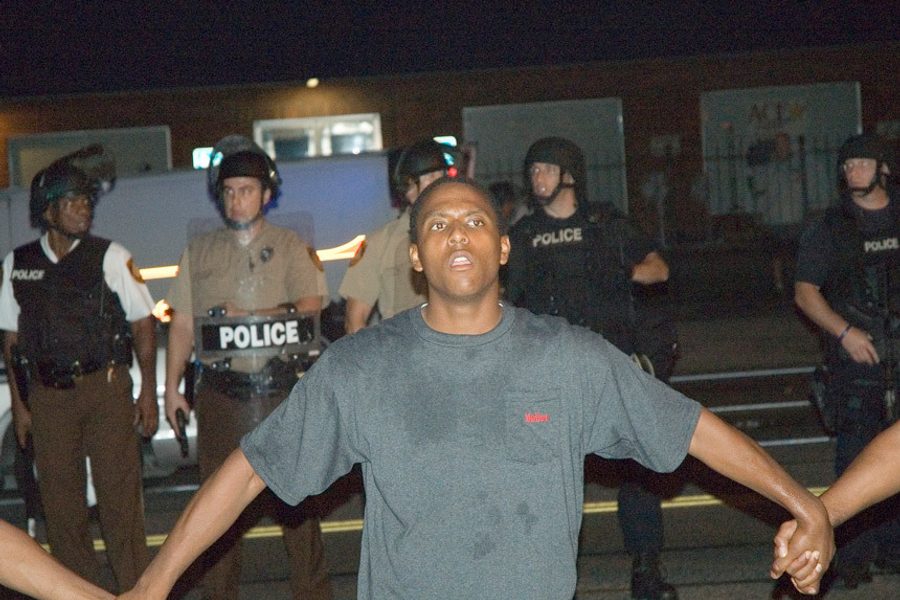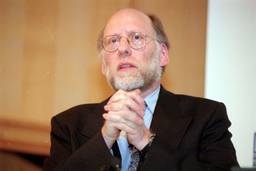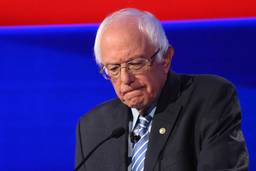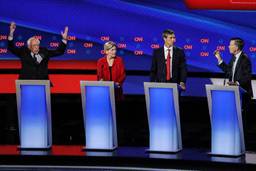#BlackTwitter and the Revolutionary Power of Horizontal Networks
The online reaction to Ferguson shows the importance of ‘mass self-communication’ that isn’t controlled by government or corporations.
Susan J. Douglas

By now the shocking photos that first ricocheted around social media, then hit mainstream media the following day, are emblazoned in our minds: robocops astride armored vehicles in camouflage uniforms, black helmets and gas masks, brandishing assault rifles.
The killing of unarmed Michael Brown by a white cop who drilled him with six bullets has blown open debates old and new, from the persistence of police brutality to the recent and outrageous militarization of the country’s police forces. But this would not have been a story if the black community in Ferguson and elsewhere had not instantly risen up and, importantly, gone to social media.
What the police action in Ferguson — and the outrage against it — exemplified was how struggles for justice are now being fought out within a new technological framework — in this case, one that pit tanks against cell phones. It is a contest between technologies of coercion and force, and technologies of information and persuasion. Typically — and tragically — the former usually trumps the latter. But not in Ferguson, despite the tear gas and bullets, both rubber and real. And the hero is “Black Twitter.”
Initially some media outlets used a picture of Brown in a cap and gown to illustrate the story. But a day after the killing, an NBC News tweet posted a photo of a threatening-looking Brown in a Nike Air jersey giving the peace sign, which some misconstrued as a “gang sign.” The next day, the hashtag “#IfTheyGunnedMeDown” followed by “which picture would they use” went viral, with young African Americans juxtaposing pictures of themselves in prom gowns, suits, or military uniforms against shots of themselves in torn jeans and T-shirts, appearing to be smoking dope, flipping the bird or also throwing “gang signs.” The meme quickly jumped to Facebook and numerous websites, with the New York Times and NPR in awe of its power. And NBC stopped using that photo.
Using the hashtag #Ferguson, and enabled by design changes that allow the posting of images and video, black residents used Twitter to scoop television and cable news, and to force them to keep Brown’s death and its aftermath a front-page story.
Their fury coincided with online exposés about other aspects of the story, like The New Republic blog post about how our tax dollars have gone to arming the country’s police departments with armored vehicles, assault rifles and, yes, grenade launchers. One day later, the New York Times ran a front-page story about “Calls to Demilitarize Police,” and stodgy old CBS news emphasized how federal programs have encouraged the spread of military-style equipment.
This event sent me back to Manuel Castells’ important work on the networked society. With the older one-to-many channels of communication now confronting interactive, horizontal networks like Twitter and Facebook, what Castells calls “mass self-communication” is playing a growing role in the resistance against oppression. It is enabling insurgent social movements to challenge institutionalized power relations. While Castells is no Pollyanna — he sees corporate and governmental interests colonizing, surveilling and seeking to tame the Internet, mobile communications and mass self-communication — he also sees a new technological regime where these struggles to “free our minds” give bottom-up folks more of a voice.
And that’s what #BlackTwitter has done. Twitter is more popular among young African Americans than whites: Forty percent of online African Americans between 18 and 29 use Twitter, compared to 28 percent of young whites. African Americans’ ownership of smart phones is above the national average, and Twitter’s 140-character limit is cell-phone friendly. Twitter has provided a space for exchanges about racism in the U.S. to flourish. Andre Brock, an expert on African Americans’ use of new media, notes that “if it wasn’t for Twitter, you wouldn’t hear the voices of the disenfranchised,” especially given how blacks are stereotyped or ignored by the mainstream media. Brock explains that Twitter’s platform is especially conducive to capturing event-specific outrage, because Twitter’s algorithm looks for spikes in hashtags when a topic is being discussed much more than it was previously. Then Facebook and even the mainstream media take note, too.
So #BlackTwitter has emerged as the one tiny point of optimism in this otherwise infuriating event. It forced national attention onto the ongoing cancer of racial violence in this country. Of course, Twitter is no match for institutional racism and media complacency, but as a crucial moment of mass self-communication and evidence of an evolving media landscape, it was an important victory, however fleeting, in the ongoing struggles for social justice.
Susan J. Douglas is a professor of communications at the University of Michigan and a senior editor at In These Times. She is the author of In Our Prime: How Older Women Are Reinventing the Road Ahead.









